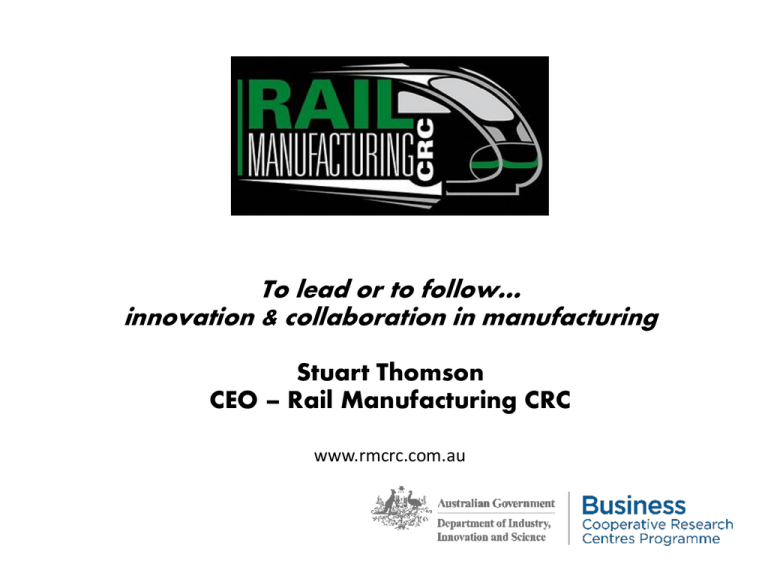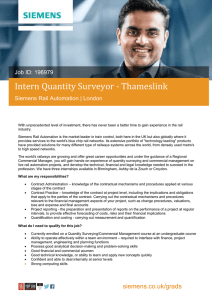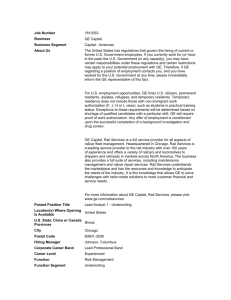To lead or to follow: innovation and collaboration in manufacturing
advertisement

To lead or to follow… innovation & collaboration in manufacturing Stuart Thomson CEO – Rail Manufacturing CRC www.rmcrc.com.au Australian rail industry snapshot 150 15,000 years employees suppliers 15 1,500 $4.2b 330 OEM & global tier 1 firms 6th 1st 42,262 largest rail network largest tram network km of track revenue Source: A Profile of the Australian Rail Manufacturing Industry, ACIL Tasman for the Department of Industry, Innovation and Science, July 2011. Supply Opportunity for Rail Tier 1 Tier 1 Tier 2 Tier 2 Tier 3 Tier 3 Rail Manufacturing : ca. 88 % of revenue = Tier 1: ca. 90% of total businesses exist in Tier 3 Opportunities: Golden era = constant demand Prime opportunity for local companies to invest in the future via innovation Examples: Innovation challenge Cirque du Soleil used innovation in an old performance genre to create a $4B organisation Kodak invented digital photography but did not capitalise on its own innovation A number of Australian manufacturing entities are bucking the downsizing trend; Auto aftermarket Mining; GroundProbe, SmartCap Software SME Rail businesses like MRX, DTI, TTG, and new industry players like Keech, Air Radiators, Airlinx, real serious games etc Innovative, nimble, and flexible. To lead, or to follow… The OECD Science, Technology and Industry Scoreboard 2013 found that Australia ranked the lowest in the OECD for collaboration on innovation with public research institutions. Manufacturing is rapidly changing – new technology, new materials, robotics and automation Government helps businesses innovate through CRCs programme, R&D tax concession, other industry assistance & grant programs Innovation is now an Australian Government priority: Industry Growth Centre into Advanced Manufacturing Innovation Policy Statement in December with new initiatives Innovation challenge for rail Rail is a globally competitive industry Innovation is key to production efficiency and wealth creation Innovative Australian businesses that collaborate are: 23 per cent more likely to report increased productivity 24 per cent more likely to report increased profitability 24 per cent more likely to employ more people Rail manufacturing in Australia has low levels of innovation compared to other sectors and other countries Less than 1% of those working in rail have R&D or science expertise Many rail businesses lack dedicated R&D resources in-house to bring innovation to business Consultation within rail industry • • • 210 participants from over 110 different organisations in the rail industry - launched in June 2012 Identified 18 Priority Opportunities out of 80 needs for competitive technologies that would help position the Australian rail industry to better meet the needs of global customers 22 Strategic Recommendations, including: Australia needs a rail manufacturing CRC Six enablers: • Governance • Standardisation & Regulation • Funding • Research • Policy • Collaboration Why a Rail Manufacturing CRC? You – the Rail Industry – said it was a priority – On Track 2040 identified need for a research organisation for Rail Manufacturing Rail manufacturing identified technological challenges to solve to remain viable and competitive, such as: • Efficient operations through increased industry capacity and reliability (quality) • Quality service through customer information, product delivery and increased safety • Efficient systems by essentially increasing productivity and process sustainability through reducing costs, lowering emissions, and limiting external impacts Cooperative Research Centres bring business and innovation together through collaboration on projects to develop new solutions, products and processes Our funding model R&D PROJECTS RMCRC Australian Government funding of $31 million x 6 years Industry Research Providers 50:50 co-funding and “In-kind” “In-kind” (research expertise & facilities) RMCRC model Rail Industry RMCRC R&D Providers • • • • Collaboration Innovation Integration & Globalisation Industry determines whether to; “Compete on price” or “Compete on value” Both options can be innovation and driven Strategic Research Themes 1. Power & Propulsion 2. Materials & Manufacturing • Energy regeneration and storage • Advanced braking systems • Electronic motors and systems • High performance materials for rail • Advanced manufacturing • Lightweight materials • Low cost manufacturing systems 3. Design, Simulation & Modelling • Advanced design and simulation • Automated health monitoring • Advanced data analysis • Energy use management tools Our Essential Participants: RMCRC Membership Benefits: Solve your technical challenges with access to the latest research Share the risk of R&D by participation in cofunded research projects Gain from RMCRC’s commercialisation model Access Australia’s leading research engineers, scientists with expertise to help solve your technical problems Become a leader in innovation for your business





